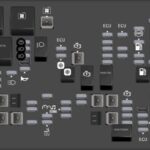Dash cameras are essential for recording driving incidents and providing evidence in case of accidents. However, powering them correctly is crucial for both functionality and vehicle safety. Using an OBD2 OBD power cable for your dash camera offers a reliable and convenient solution. This article explores the options for powering your dash cam through the OBD2 port, focusing on safety and efficiency.
Utilizing Your Vehicle’s OBD2 Port for Dash Cam Power
The OBD2 port, initially designed for vehicle diagnostics, can also power devices like dash cams. This eliminates the need for messy wiring and ensures a constant power source, even when the engine is off, depending on your vehicle’s configuration. There are several ways to leverage the OBD2 port for your dash cam:
OBD2 Power Adapters with Low Voltage Cutoff
For vehicles with always-on cigarette lighters, a male-to-female cigarette lighter adapter with a low voltage cutoff switch, coupled with a cigarette lighter to USB adapter, is a viable option. This setup protects your car battery from draining by cutting off power to the dashcam when the voltage drops below a safe threshold (e.g., 11.6 volts). Products like the Koolatron “battery saver” offer this functionality.
Direct OBD2 to USB Power Cables
If your cigarette lighter is only active when the engine is on, a dedicated OBD2 to USB power cable provides a direct connection to the dash cam. These cables often include a voltage cutoff feature to prevent battery drain. They are readily available and inexpensive on online marketplaces like Amazon. This method avoids modifying existing wiring and provides a clean installation.
Hybrid Approach: OBD2 and Cigarette Lighter Power
A flexible solution involves using both the OBD2 port and the cigarette lighter. Run a USB cable from the dashcam to an accessible point under the dash. Utilize an OBD2 adapter when parked for parking mode recording and switch to the cigarette lighter power when the engine is running. This approach maximizes recording capabilities while minimizing battery drain.
Important Considerations for OBD2 Dash Cam Power
When using the OBD2 port for dash cam power, keep these factors in mind:
Power Capacity
The OBD2 port typically supplies up to 4 amps. Most dual dashcams require 2 amps or less, ensuring sufficient power without overloading the port. Using a high-quality splitter with a minimum 10-amp rating allows for powering multiple devices without compromising performance.
Easy Access for Diagnostics
Using an OBD2 adapter for your dash cam doesn’t interfere with vehicle diagnostics. Simply unplug the adapter when you need to connect a diagnostic scanner.
Professional Installation (Optional)
While installing an OBD2 power cable is relatively straightforward, professional installation is recommended for those unfamiliar with car wiring. This ensures correct connection and avoids potential damage to the vehicle’s electrical system.
Conclusion
Powering your dash camera through the OBD2 port offers a safe and efficient solution. By choosing the appropriate setup based on your vehicle’s cigarette lighter functionality and utilizing features like low voltage cutoff switches, you can ensure continuous recording without risking battery drain. OBD2 power cables provide a clean and convenient way to integrate your dash cam into your vehicle’s electrical system.

